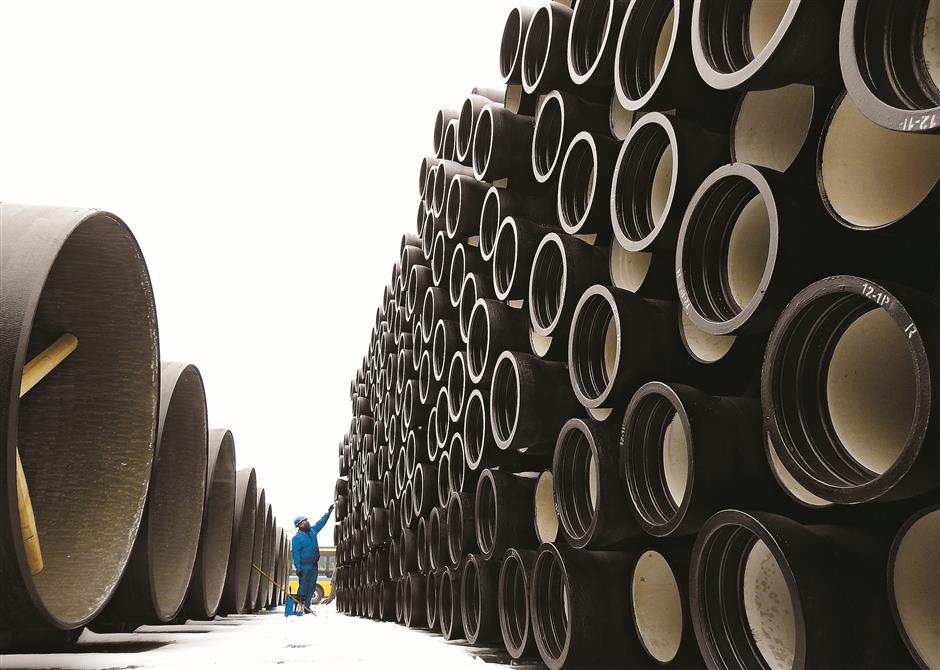Steelmakers on alert for tariffs despite little near-term damage

A worker checks steel pipe made in China to be shipped abroad at the Lianyungang Port in Lianyungang city, Jiangsu province.
China’s steelmakers need to heed US tariffs that are likely to trigger trade frictions despite little damage being done in the short term, according to analysts.
China exported 9.5 million tons of steel in the first two months this year, down 27.1 percent from a year ago, the General Administration of Customs said last week.
Although the drop was mainly caused by increases in domestic steel prices, “whether the situation will improve is
now linked with US further steps afterthe tariffs on steel and aluminum,” said Chen Kexin, chief analyst at Lange Steel
Information Center, a steel industry consultancy.
One day after the release of Chinese export data, US President Donald Trump announced that a global 25-percent tariff
will be imposed on steel imports and 10-percent on aluminum. Previously, he railed against China as the world’s largest
steel exporter accounting for most of global overcapacity.
The move, aimed at protecting American industry, has triggered worldwide anxiety, with the Ministry of Commerce in China warning the rebound of protectionism in the US will lead to opposition from the globe while hurting its own industries as well.
In fact, the action currently “will have little direct impact on China’s steel industry as Chinese steel only accounted for less than 2 percent of US steel imports last year,” Chen said.
“But domestic steelmakers should still stay alert, in case the friction expands to more products,” he said. Despite low exports in steel, China’s economy is boosted by exports of heavy machinery and electronics products, which are downstream from steel.
China exported 8.95 trillion yuan(US$1.41 trillion) of machinery and electronics last year, up 12.1 percent from a year ago, 58.4 percent of the nation’s total exports.
Heavy machinery, which takes up around 15 percent of China’s steel consumption, posted a record high of US$20.1 billion in exports last year, with the United States being the largest foreign buyer.
Despite the fact that China’s portion of US steel imports is minimal, “but what if the steel tariff is just the first step? The influence could be immense if the policy extends into areas such as heavy machinery and electronics,” Chen said.
In many analysts’ view, that could be possible, “as for years US has been squeezing China out of its use of steel, likely to protect its industrial development as a whole from China’s expanding clout as steel is the main industrial raw material,” said Wang Guoqing, Lange’s research director.
While in 2006 the US bought 12.56 percent of China’s exported steel, the figure dropped to 1.57 percent last year, “amid more and more frequent and stringent anti-dumping investigations from US to China,” Wang said.
The US proposed 169 items concerning anti-dumping in steel industry last month, of which 29 were aimed at China. It said that China’s steel overcapacity had exceeded total US steel production.

While in 2006 the US bought 12.56 percent of China’s exported steel, the figure dropped to 1.57 percent last year, according to Lange Steel Information Center, a steel industry consultancy.
While Trump aims to boost the US steel industry via the tariffs, “he has been long calling for the return of US manufacturing,” said Jiang Mingde, chief counselor at domestic private equity Yixinweiye Fund.
“Steel and aluminum could be just the start of his massive actions,” as the nation aims at consolidating its “real economy” to lower the portion of finance and consumption in its economy, Jiang added.
“In that sense, although the steel and aluminum tariffs seem friendly fire at this moment, fear exists that a larger range of trade frictions would hurt China,” he said.
China has been upgrading its steel industry in recent years by cutting oversupply and phasing out inefficient plants, with the price of steel rising 23 percent in 2017 after jumping 66 percent in 2016 amid a cut of 115 million tons in capacity over the two years.
But, meanwhile, the parallel task is to fight for higher competitiveness in the global market, backed also by mergers among giants such as Baosteel and Wuhan Steel, in a move to “enhance the industry’s competitiveness and better resist price fluctuations in global trades,” the nation’s steel industry association said.
The aim, however, could contradict with the current situation amid the US restrictions. Despite being the largest steel exporter, China’s domestic market accounts for over 90 percent of its steel consumption.
“It is for sure steelmakers also eye the global market for profit,” Wang said. “But more or less, they are now under
pressure of US restrictions, with further moves to see.”















